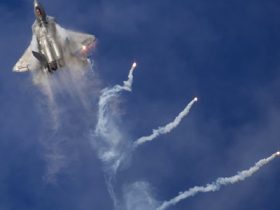Boeing’s fighter-jet workforce just went on strike in St. Louis. The strike affects more than 3,000 machinists across St. Louis and St. Charles, Missouri, as well as Mascoutah, Illinois, after they rejected a new four-year contract proposal on Sunday. The New York Times calls the stoppage “the first in nearly three decades for the local chapter of the International Association of Machinists and Aerospace Workers, IAM District 837.”
At stake: “Boeing’s smaller military business supplies advanced jet fighters such as the F-15 and F/A-18, as well as key parts of the munitions supply chain. The company last week reported a second quarter of stable performance in its defense segment during a phase of surging demand for missiles and other weaponry from the Pentagon and other allied countries,” the Wall Street Journal reports. The rejected deal “would have raised the average wage by roughly 40% and included a 20% general wage increase and a $5,000 ratification bonus. It also included increasing periodic raises, more vacation time and sick leave,” Reuters reports. “However, the proposal removed a scheduling provision that would have affected workers’ ability to earn overtime pay,” the Associated Press adds.
Boeing reax: “We are prepared for a strike and have fully implemented our contingency plan to ensure our non-striking workforce can continue supporting our customers,” Dan Gillian, Boeing Air Dominance vice president and general manager, said in a statement. “We’ll manage through this. I wouldn’t worry too much about the implications of the strike,” CEO Kelly Ortberg told analysts last week.
Extra reading: AP put together a history of labor strife at Boeing, which you can read over here.
The Pentagon is planning its first test of the Golden Dome missile defense system just before the 2028 election, CNN reported Friday. “Right now, the project is all about moving quickly and relying on existing systems to show that the broader concept of a massive missile shield is worth more funding,” a source told CNN.
Some inside the Defense Department are skeptical of the timeline. “In the end, a lot of money could be spent trying to make this work, and then it might not even meet testing requirements or do what they want it to do,” one defense official said. More, here.
The Army’s giant data deal with Palantir is a harbinger, service CIO says. The service collapsed 75 data and software contracts into one contract potentially worth $10 billion—it was awarded to Palantir last week—and it’s how the service wants to buy software. “We have a lot of big software packages that are out there. They’ve been bought over several years, several program offices, several commands [and] not getting a lot of parity across the board on how they’re being delivered. Adding a lot of complexities,” Army CIO Leonel Garciga told reporters. “But our intent is to continue to move down this path, to really focus on reducing that complexity, adding agility to how we buy….[and] save taxpayer dollars as much as we can.” Defense One’s Lauren C. Williams has more, here.
Related: “Palantir Is Extending Its Reach Even Further Into Government,” WIRED reported Friday.
Trump’s Navy secretary wants to boot 60 civilian professors from the Naval Academy to curb the institution’s diversity efforts, Fox reported Thursday. The plan was described in a draft memo from Secretary John Phelan to Scott Duncan, acting Assistant Secretary of the Navy for Manpower and Reserve Affairs.
Why expand the permanent military professors from 40 to 100? To address “imbalances in civilian-dominated governance that weaken the Academy’s military mission,” the memo reads.
Phelan: “The previous administration instilled corrosive DEI programs in the Academy’s curriculum and allowed identity politics and wokeism to take priority over warfighting, leadership, and the critical thinking necessary to be superior Naval and Marine Corps officers,” the secretary said in a statement to Fox.
If it sounds familiar, the Air Force Academy’s superintendent pitched a similar plan. The Denver Gazette reported in April that the USAFA plan “intended to increase the percentage of military service members among the faculty up to 80% and bring the percentage of civilians down from about 37% to 20%…To meet the proposed goals, 105 civilian positions would have to be cut.”
Elsewhere around the Navy, the service’s ships are “languishing in repair yards,” the Wall Street Journal reported Sunday in an update to a trend that’s been well-reported for several months, as we explained in a November podcast.
The gist: “Repairing naval vessels often takes longer than scheduled. Roughly a third of surface ship maintenance wasn’t completed on time last year, Navy officials have said. In recent years as much as two-thirds has been late, and officials have said improvement is needed to hit the Navy’s combat-readiness target.”
And in commentary, learn about lessons from this year’s unfunded priority lists, gleaned by AEI’s Elaine McCusker and John Ferrari, writing Sunday for Defense One.
Additional reading:
Welcome to this Monday edition of The D Brief, a newsletter dedicated to developments affecting the future of U.S. national security, brought to you by Ben Watson and Bradley Peniston. Share your tips and feedback here. And if you’re not already subscribed, you can do that here. On this day in 1790, President George Washington authorized 10 ships to enforce tariffs and trade laws, creating the U.S. Coast Guard.
Around the world
China is restricting the sale of rare earths to U.S. and allied defense manufacturers, “delaying production and forcing companies to scour the world for stockpiles of the minerals needed to make everything from bullets to jet fighters,” the Wall Street Journal reported Sunday. “As a result, one drone-parts manufacturer that supplies the U.S. military was forced to delay orders by up to two months while it searched for a non-Chinese source of magnets, which are assembled from rare earths.”
In a related case, “Earlier this year, one U.S. defense supplier, the United States Antimony Corporation, tried to ship 55 metric tons of antimony mined in Australia to its smelter in Mexico. The load transited via the Chinese port city of Ningbo—until recently a routine practice.” But Chinese customs officials held the shipment for three months, and eventually “released the shipment in July, on the condition that it be sent back to Australia and not to the U.S.” However, upon arrival in Australia, “United States Antimony learned that product seals had been broken. It is currently working out whether the antimony has been tampered with or contaminated.” More, here.
ICYMI: “Official statements and state-linked commentators have since made clear that this new export-license system is designed to increase Beijing’s leverage over Pentagon supply chains. It may, in fact, become a signature tool of great power competition,” wrote Peter Singer and Tye Graham for Defense One’s The China Intelligence column.
From the region:
Update: Germany will fast-track two Patriot anti-missile systems to Ukraine as part of a deal to buy two new Patriot systems from the U.S. for Berlin, Defense Minister Boris Pistorius announced Friday.
Meanwhile, the U.S. and NATO are working with Ukraine to create a new way to arm Kyiv, Reuters reported Friday. Under the plan, “Ukraine would prioritize the weapons it needs in tranches of roughly $500 million, and NATO allies—coordinated by NATO Secretary General Mark Rutte—would then negotiate among themselves who would donate or pay for items on the list.”
One alliance official called the plan “a voluntary effort coordinated by NATO that all allies are encouraged to take part in.”
The fine print…is still being worked out. “Money for the arms would be transferred into a U.S.-held account, possibly at the U.S. Treasury Department, or to an escrow fund, although the exact structure remains unclear,” Reuters writes. Read the rest, here.
Additional reading:
Trump 2.0
The Pentagon is preparing to widen its use of the military for domestic purposes like the Los Angeles deployment in June to protect Immigrations and Customs Enforcement agents as they arrested people for possible deportation, a memo obtained by the New Republic reveals.
In short, “DHS is anticipating many more uses of the military in urban centers, noting that L.A.-style operations may be needed ‘for years to come,’” Greg Sargent of TNR reported Saturday.
“The memo was authored by Philip Hegseth—the younger brother of Defense Secretary Pete Hegseth—who is a senior adviser to Homeland Security secretary Kristi Noem and DHS liaison officer to the Defense Department,” and it outlined a July 21 meeting with “Defense Secretary Pete Hegseth and several of his top advisers, Joint Chiefs chairman Dan Caine, and NORTHCOM Commander Gregory Guillot.” The document states DHS officials are seeking “a verbal agreement to find places where DoD can detail personnel within ICE and CBP (and vice-versa) to increase information sharing, and specifically support nationwide operational planning capabilities.”
Expert reax: “This memo is talking about turning internal homeland security into a regular Defense Department activity, which it is not. This is not normal,” said Lindsay Cohn, an associate professor at the U.S. Naval War College. More, here.
Deportation nation update: Nine out of 10 participating nations are human-rights violators. “The U.S. has solicited 64 nations to participate in its growing global gulag for expelled immigrants,” Nick Turse of the Intercept reported last week. But “Fifty-eight of them—roughly 91 percent—were rebuked for human rights violations in the State Department’s most recent human rights reports,” he writes.
Trump threatened “Nuclear Submarines” in tit-for-tat with Putin pawn. Last week, President Trump said he might impose sanctions on Russia if no progress was made on ending its war on Ukraine. Russia’s Dmitry Medvedev responded by warning the U.S. president against a “game of ultimatums.” Trump then said Medvedev should “watch his words,” whereupon Medvedev alluded to Russia’s Soviet-era nuclear arsenal.
Which brings us to Friday: “Based on the highly provocative statements of the Former President of Russia, Dmitry Medvedev…I have ordered two Nuclear Submarines to be positioned in the appropriate regions, just in case these foolish and inflammatory statements are more than just that,” Trump said in a social media post. Reuters has a bit more, here.
Former Naval War College professor Tom Nichols called the move “reckless,” writing Friday in The Atlantic. “It is, in fact, news when the most powerful man on Earth starts talking about nuclear weapons,” Nichols wrote, suggesting Trump announced the submarine moves to distract from bad economic news Friday. Trump “has initiated a new era in which the chief executive can use threats regarding the most powerful weapons on Earth to salve his ego and improve his political fortunes,” Nichols said, and added, “Nuclear-missile submarines are not toys.”
Russia’s reax: “Kremlin plays down Trump submarine order, urges caution on nuclear rhetoric,” Reuters reported Monday from Moscow.
Additional reading:
Lastly today: commentary by AEI’s Kori Schake via her essay, “Dispensable Nation: America in a Post-American World,” published by Foreign Affairs in late June. “Trump and his advisers seem to believe that, despite the country’s allegedly parlous condition, unilateral action on Washington’s part can still force others to capitulate and submit to American terms. But since the end of World War II, American power has been rooted mostly in cooperation, not coercion…”
In conversation: Schake talked to NPR’s Sarah McCammon on Saturday’s “All Things Considered.”
Read the full article here








Leave a Reply